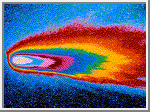 Halley's Comet
Halley's Comet Halley's Comet
Halley's Comet

Halley's [HAL-lee] Comet has been know since at least 240 BC and possibly since 1059 BC. Its most famous appearance was in 1066 AD when it was seen right before the Battle of Hastings. It was named after Edmund Halley, who calculated its orbit. He determined that the comets seen in 1531 and 1607 were the same object that followed a 76-year orbit. Unfortunately, Halley died in 1742, never living to see his prediction come true when the comet returned on Christmas Eve 1758.
Halley's Comet put on bright shows in 1835 and in 1910. Then in 1984 and 1985, five spacecraft from the USSR, Japan and Europe were launched to make a rendezvous with Halley's Comet in 1986. One of NASA's deep space satellites was redirected to monitor the solar wind upstream from Halley. Only three comets have ever been studied by spacecraft. Comet Giacobini-Zinner was studied in 1985, Comet Halley in 1986, and CometGrigg-Skjellerup on July 10th, 1992. The nucleus of Halley is ellipsoidal in shape and measures approximately 16 by 8 by 8 kilometers (10 by 5 by 5 miles).

 Ion Tail
(GIF, 1M)
Ion Tail
(GIF, 1M)
The well developed tail structure of Comet Halley was captured in this
image taken March 5, 1986. At this point in its orbit, Halley had
recently passed perihelion on February 9, 1986 and was at its most
active. This 10 minute exposure was recorded at Mauna Kea Observatory
on IIIa-J emulsion without filters. This image shows both the ion and
dust tail, with the latter stretching for over 6 degrees on the sky.
(Courtesy NASA/JPL)
 Detachment Event
(GIF, 310K)
Detachment Event
(GIF, 310K)
One of the more spectacular changes recorded for Halley during an
apparition was the detachment event that occurred on April 12, 1986.
This 3 minute exposure was taken using the Michigan Schmidt telescope
at Cerro Tololo Interamerican Observatory. The resulting image clearly
shows part of the ion tail structure detached from the comet. At this
period, the orientation of the comet is such that the tail is
foreshortened, with the prolonged radius vector pointing west of north.
(Courtesy NASA/JPL)
 Ray Structure
(GIF, 1M)
Ray Structure
(GIF, 1M)
An example of the ray structure of Halley was captured on March 19, 1986,
at the Mount Wilson/Las Campanas Observatories. This 10 minute exposure
was recorded at the focus of the 100 inch telescope on Las Camapanas in
Chile. The close up image, covering the inner 1 degree of the comet,
shows a prolonged radius vector extending to the left.
(Courtesy NASA/JPL)
 Halley's Comets in 1986
(GIF, 158K)
Halley's Comets in 1986
(GIF, 158K)
This image of Halley's Comets was taken during its 1986 appearance.
False-color digital enhancement was used to permit measurement of slight
brightness differences.
(© Copyright Royal Observatory, Edinburgh)


 Comet
Comet
 Shoemaker-Levy 9 Background
Shoemaker-Levy 9 Background
